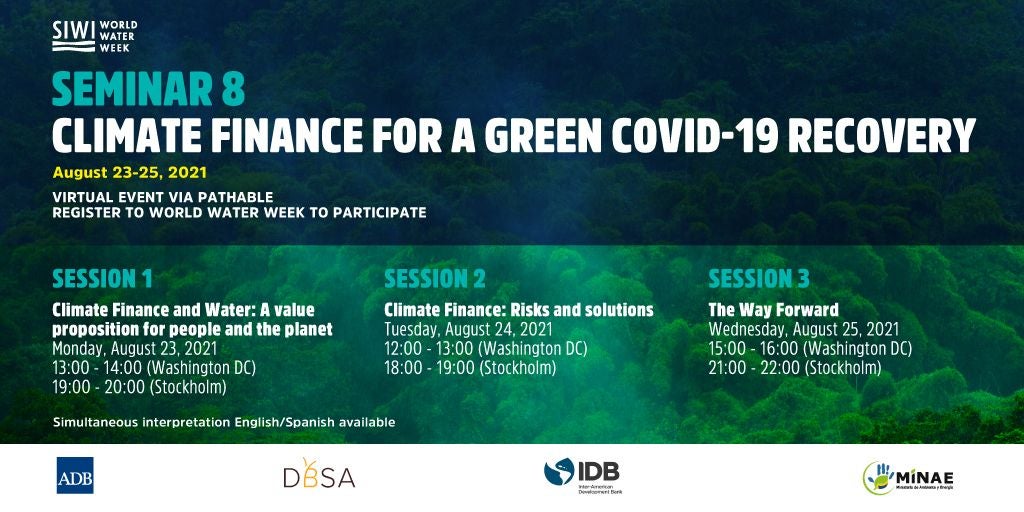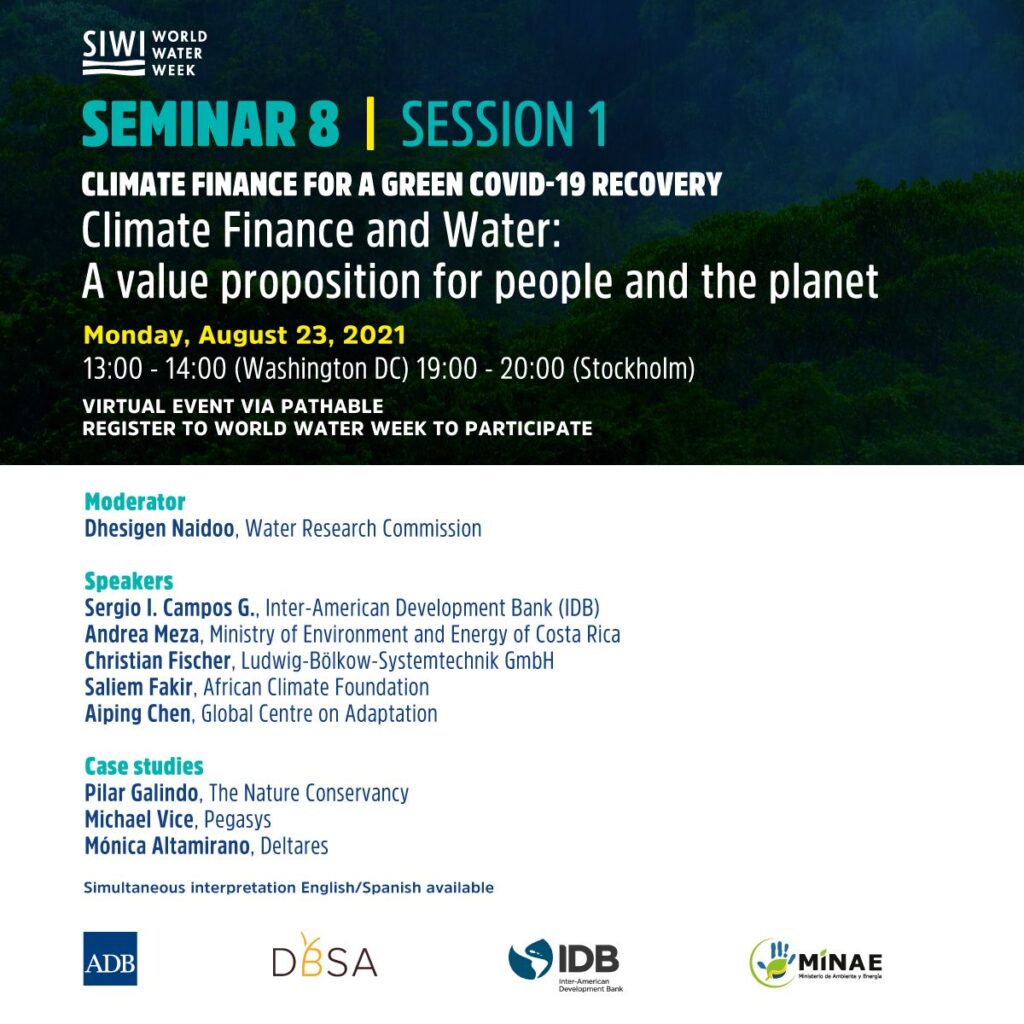The increasing variety of climate, water and biodiversity funds and financing facilities, has the potential to increase complementarity. In practice, this increasing fragmentation is becoming a systemic barrier for local access to finance.
By Mónica Altamirano*
The development of novel governance structures for collective investments at watershed level and innovative procurement strategies is required to deal with the remaining systemic barriers for private sector participation.
A public-private programmatic approach that enables the combination of multiple thematic finance streams is required along with non-traditional global-local partnerships that bring the required expertise to effectively de-risk and significantly reduce transaction costs for investments at the watershed scale.
As stated by the UNEP Adaptation Gap Report 2020, the adaptation finance gap is not closing, despite an increase in available financing. The private sector remains an untapped source of financing and expertise. Private sector engagement in adaptation is crucial, not only to close the implementation and financing gaps of National Adaptation Plans (NAPs), but more importantly to ensure the long-term financial sustainability of these investments.
The impacts of Climate Change will be channeled primarily through the water cycle (World Bank 2016). This overlap adds challenges and opens up opportunities. Because climate-resilient solutions to water challenges require collective action and investments at system or watershed scale, private sector participation is complex. However, climate finance also opens up opportunities for the creation of new markets that address both the global climate and water crises.
Climate finance has been envisioned to enable the shift towards a new, inclusive and more resilient economic development paradigm. In operational terms, climate finance therefore should be aimed at the removal of systemic barriers that hinder adoption of more regenerative value creation models and the transition to resilient infrastructure systems that embrace the resilience dividends. In our study, we assessed the current and potential roles of climate finance in unlocking private sector investments in adaptation, and to bring about and scale up this transformation.
To identify levers to unlock private sector investments, we analysed global climate finance flows as well as the investment portfolio and evolution of three multilateral climate funds (MCFs) between 2010 and 2020: the Pilot Program for Climate Resilience (PPCR), which is part of the larger Climate Investment Funds(CIF); the Adaptation Fund (AF); and the Green Climate Fund (GCF). We validated our findings through interviews with experts from these funds.
Additionally, we identified and analysed pioneer projects and financing mechanisms of Multilateral Development Banks (MDBs) and impact investors in Africa, Latin America and Asia. In our report, four private-sector-financed adaptation cases supported MCFs and three by MDBs are presented in greater detail. Additionally, the possible variety of public-private cooperation models is illustrated through nine flood protection projects in the UK, the Netherlands, Australia and Costa Rica; each with varying shares of private finance.
Remaining systemic barriers
We observed that most private sector windows of climate funds have focused their efforts on setting financing facilities to reduce the cost of capital for adaptation, (mostly in the agricultural sector) and working with financial intermediaries.
The most important systemic barriers, which go beyond the cost of capital, are yet to be tackled:
- Transaction costs that stem from the scale (watershed and/or landscape) needed for effective adaptation investments.
- Transition risks that stem from the innovative nature of many of the adaptation technologies and/or solutions required, for example Nature-based Solutions.
The most effective ways to lower transaction costs are governance structures and reliable information and monitoring systems that enable private sector companies willing to reduce their water risks to design and implement effective adaptation measures beyond their fences.
These barriers can only be tackled by Public-Private programmatic approaches. An example of such a programmatic approach is the one pioneered by the PPCR. The PPCR programmatic approach adopts a long-term blended finance strategy and combines public sector led interventions with targeted and well synchronized private sector instruments.
Two of these pioneering programs are the CLIMADAPT program in Tajikistan and the Zambia Strategic Pilot Program for Climate Resilience (SPCR). CLIMADAPT is a climate resilience facility pioneered with funding from EBRD and PPCR, which engages local banks and microfinance institutions in lending to small businesses and households. The program facilitates and accelerates the adoption of technologies and practices that reduce soil erosion and pressure on water and energy resources. From the launch of CLIMADAPT up to the end of September 2018, PFIs financed over 3,400 sub-projects, with a total value of US$ 9.8 million. Of the sub-projects financed to date, 62 per cent have been aimed at the adoption of energy-efficient and renewable-energy technologies, 36 per cent at promoting water efficiency and 2 per cent at adopting sustainable land-management practices.
This PPCR program in Zambia is aimed at the Kafue and Barotse sub-basins of the Zambezi River, areas which are inhabited by vulnerable communities and prone to floods and droughts. The Zambia PPCR is structured in two phases and includes a Project Preparation Grant. The program is anchored on three strategic components: participatory adaptation, climate-resilient infrastructure and programme support. It is an illustrative example of a blended finance approach that makes strategic use of public and concessional funds to gradually build capacity and awareness in both the public and private sectors. It helps create the enabling environment to increase private sector participation through the adoption of public-private partnerships and the uptake of innovative business models, e.g. parametric insurances and micro-insurance products.
Need for co-creation of next-generation investment vehicles
The water community can make a difference and leverage both a greater share of climate finance towards water security while catalysing transformative private sector investments in adaptation by:
- Working together with MCFs, MDBs and donors needs to intensify upstream coordination to remove systemic access barriers and reduce the transaction costs faced by local public and private actors.
- Playing a catalytic role downstream by working with national and local governments, NGOs and the private sector to strengthen adaptation project preparation capacities.
- Rethinking water resources planning processes to strengthen the climate rationale of the proposed investments, enhance their potential to drive systemic change and exploit the full potential of private sector participation.
The water community is best suited to work hand in hand with MCFs and MDBs, supporting national and local governments in the development and testing of governance structures, financing mechanisms and blueprints for private investments in adaptation at the watershed scale. Implementation arrangements fitting local socio-economic and institutional conditions are effective in aligning incentives between multiple stakeholders. Governance structures that create intrinsic incentives for both environmental and financial sustainability, leverage multiple economies of scale and scope. And last but not least, structures effective in reducing the now prohibitive transaction costs faced by companies willing to be water stewards.
A public-private programmatic approach that enables the combination of multiple sectoral finance streams is required along with non-traditional partnerships that bring the required expertise to effectively de-risk and significantly reduce transaction costs for investments at the watershed scale.
Editor’s note: this article is a co-publication with Water Science Policy.
*Mónica Altamirano is a specialist at Deltares, an advisor to Netherlands Ministry of Infrastructure and Water Management, and a partner at NOW Partners. With 18 years of global experience in public-private partnerships (PPPs), she is a multidisciplinary leader who has advised governments on how to catalyze private sector investments in infrastructure, water, and climate adaptation. Her work aims at making adaptation and water security financially feasible for developing countries. She holds a PhD in Economics of Infrastructures and a MSc in Systems Engineering, Policy Analysis and Management from Delft University of Technology.



Leave a Reply